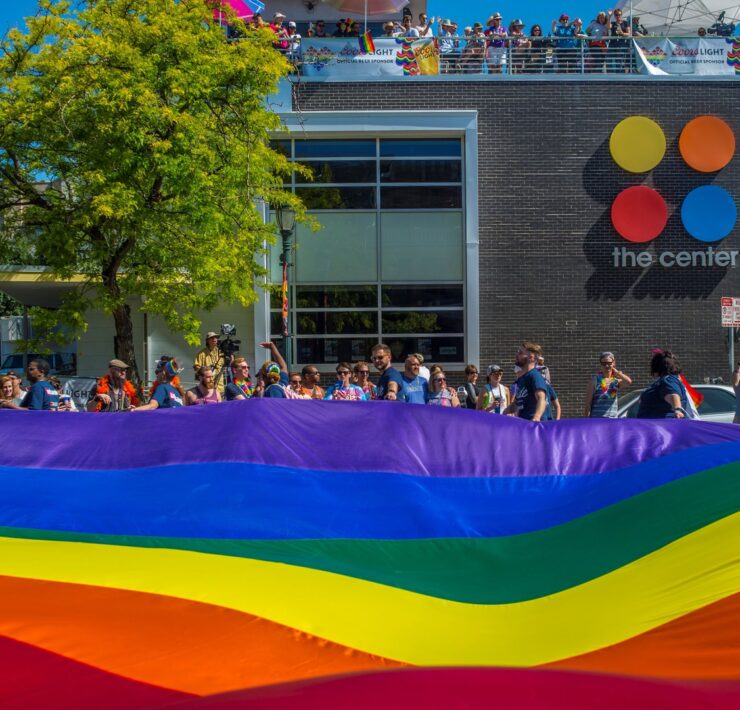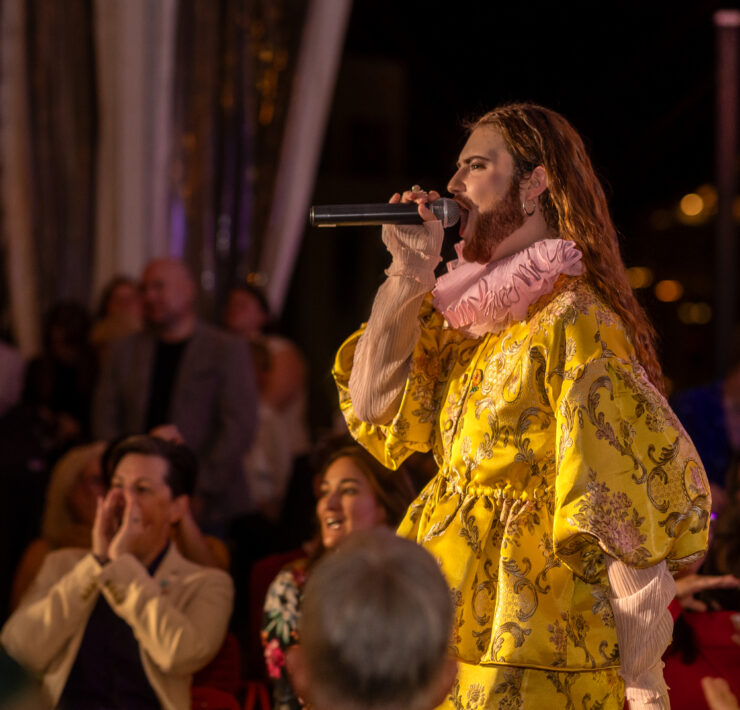Band of brothers: those who suffered in Colorado were first to fight AIDS

Out Front contributor Nic Garcia is a lifelong journalist and…
It was Barry Gaspard who first saw it coming.
The gay men’s cancer that had been wreaking havoc on the coasts would not just affect those clusters of men in San Francisco and New York. What would become known as AIDS would strike his community, Denver, too.

Gaspard, an epidemiologist for Colorado’s Department of Public Health and environment, had already begun to see a rise in syphilis, gonorrhea and Hepatitis B. In 1981 he launched Safe Week, a campaign to get gay men tested for the venereal diseases.
“He was the leader,” Barry Krzywicki said.
Kryzwicki, freshly out of college, worked along Gaspard.
“He was the one that started the Gay, Lesbian Health Alliance of Denver. He spearheaded the effort. I was just a volunteer and then an employee.”
More men got tested. And as Gaspard believed, more cases of syphilis and gonorrhea were discovered. For the first time in the young community’s history an emphasis was being placed on health.
But what Gaspard and Kryzwicki didn’t know – what no one knew – was that a virus was rapidly spreading in gay men across the nation that would lead to the deaths of thousands in Colorado.
It snuck up on us. Men on the East and West coasts were hospitalized with a cancer, kaposi’s sarcoma, and a rare form of pneumonia, carinii. Doctors were baffled. The mainstream media began to report gay men were dying of mysterious causes.
The public freaked. And fear was settling in gay communities across the nation.
“Before we saw any cases in Colorado, there were articles in journals and in major newspapers,” Kryzwicki said. “The press picked up AIDS from the CDC. Some of my co-workers asked me, ‘aren’t you nervous?’ It was this abstract thing that no one really knew anything about. But once it started coming, when people, your friends started to die … it became very real.”
But information was slow to trickle in to the flyover states.
“There was no Internet,” said former director of People With AIDS Coalition Chad Kenney. “Anything that was being written was being written in medical journals.”
Despite no reported cases of AIDS in Colorado, the gay community in Denver began to mobilize behind Gaspard’s GLHAD. Meetings started in spring of 1982. How would the Denver gay community react to AIDS? How could we minimize harm? How could we keep our brothers safe? How could we win over pubic support? How could we partner with the government – any government – to help us through the crisis?
Information had also begun to be distributed. The Guide, a monthly community magazine, devoted its entire March issue to the topic of AIDS. More and more pamphlets would be circulated.
By November 26, 1982, four cases of AIDS were reported in Colorado. GLHAD was focused on fundraising and enough money had been donated to rent a space for the AIDS support group to meet for six months. The GLBT Community Center had established a rumor control system through its telephone information program, and a support group.
The Center attempted to do more. But as needs increased it became apparent a separate organization was needed. The Colorado AIDS Project was formed in 1983.
Kenney was one of CAP’s original volunteers. He was recruited with four others to work in the client services department. But soon he found himself alone. The others had dropped out.
It was at CAP’s office – an attic at St. Paul’s Church – in 1984 that Kenney met Barry Glass, one of the organization’s first directors of client services.
“We were taking care of each other all while witnessing our future,” Glass said. “The devotion that went along with AIDS – that was intense.”
The sick took care of the sick.
As the number of cases rose, so did fear. But it wasn’t just the virus a gay man had to be afraid of. If you were gay, being quarantined was not a phobia, but a reality, said THRIVE:The persons living with AIDS initiative of Colorado Managing Director Arthur Powers.
“In the course of attending meetings and reading on what would become known as AIDS, we ultimately began to reach out to the community to run education and outreach meetings with different groups,” Powers said.
Powers said special attention needed to be paid to community members with disabilities. His first outreach meeting was with the Rainbow Society for the Deaf.
Every sub-culture of the gay community – from drag queens to leather daddies – was incorporated in the initial outreach during the AIDS epidemic, Powers said. It would prove to be the first challenge for the “vibrant” community since the initial Stonewall riots and fight for liberation.
“We were just thrown together,” Glass said. “We had a combat mentality.”
And fight they did.
While AIDS had subsumed the entire community’s health agenda and strapped it for cash – there were no federal dollars for what limited services were available – another threat was looming. In 1986, State Rep. Dale Erickson, a Republican from Fort Lupton, had introduced HB 1290.
“It was an ambush,” Powers said.
Had the bill passed, it would have permitted health departments and other officials to quarantine anyone coming out of a gay bar.
There was no due process protection. No right to legal representation. Moreover, anyone could be tested for HIV without prior knowledge and consent, and their name made public.
Enter Tom Witte.
Witte ran an advertising firm in Denver. Living with AIDS himself, Witte led the effort to block the aforementioned legislation by setting up Coloradans for Sane AIDS Policies. Powers was by his side.
It would be one of the first time the LGBT community went to the Capitol to lobby with gusto. And their efforts would be successful.
“By the time Tom and our crew got done, Rep. Erickson was so upset with all the amendments he yanked the bill,” Powers said. “The bill had become ‘too much of a gay rights bill.’”
By August of 1986, Witte and Powers knew it wouldn’t be the last challenge.
Denver Republican Rep. Dottie Wham was set to introduce her own bill the following year.
Wham’s bill was nearly identical to Erickson’s.
“The degree to which I saw my colleagues marginalized infuriated me,” Powers said.
So Witte’s crew strategized, and researched. They looked to other states – few had moved on anything AIDS related – for guidance.
One of the best paths forward was a commission that would report to then-Gov. Roy Romer.
“Tom was tactically shrewd,” Powers said. “He was hoping Wham’s bill would be held up while the commission would meet and make recommendations. But it didn’t work that way.”
Wham’s 1987 bill went forward as introduced. While a committee made significant amendments in our community’s favor, Wham pulled a political coup and sent her bill to the Senate as she had intended.
But Powers worked the political process and made allies in the Senate where his own alternative bill was introduced – and passed.
After more lobbying by the organization now known as the Coalition for Political Responsibility, Power’s bill was passed in the House.
In it were protections for those quarantined – the right to legal representation, a provision that no person could be held for more than 48 hours and the right to refuse to comply and have district court review.
Colorado was the first state to debate the rights for people living with HIV, and the third state to pass legislation.
Powers would eventually become the community’s full-time volunteer lobbyist at the Capitol, never raising a dollar to pay himself for his sentinel function.
Soon after the political victory, more organizations to further the LGBT agenda sprung up: The Colorado Gay and Lesbian Task Force, ACT UP Denver and Colorado AIDS Legislative Association.
While Powers was working with Witte and others at the Capitol, the likes of Kenney and Glass were focused on supporting the community in other ways.
Shortly after being diagnosed with HIV, Kenney was elected to the board of the Persons With AIDS Coalition of Denver that operated the Denver’s Buyers Club and the newsletter Resolute.
It was street-level activism, he said.
The group provided services – connecting people with AIDS to critical and expensive medication and vitamins – and information no other sources had. Resolute had a nationwide following, often providing the best information about HIV/AIDS and services.
“Before I tested positive, I was advocating for ‘them, over there.’ Then I found myself advocating for myself. For all of us.”
Glass moved to San Diego and then back to Denver. “Between jobs,” Glass founded Bearing Witness, an organization to foster and archive art created by people living with AIDS.
“We wanted them to express their lives from within the crisis.”
Powers believes there is a direct correlation between the success of the gay community during the AIDS crisis – and there after – and the emergence of Amendment 2, a 1992 ballot initiative sponsored by a Colorado Springs car dealer that would forbid any Colorado government from extending protective status to the LGBT community.
“They wanted to push us back in the closet,” Powers said.
The initiative was born out of the enhanced stigma toward gay men AIDS created. And it became law but was eventually overturned by the U.S. Supreme Court in 1996.
More men died throughout the four-year legal battle. An entire generation – including Gaspard and Witte – was lost.
“There was a tremendous loss of incredible, creative, wonderful people,” Krzywicki said.
After a successful rollout of new HIV-suppressing drugs, protease inhibitors, the number of AIDS-related deaths dropped. At the time, the mainstream media reported the drugs were the end-all cure to AIDS.
But that wasn’t the case. The fight continues today for a cure. For a vaccine. For a way to eliminate stigma.
The question is, as Glass put it, “what did you do during the war?”
If, indeed, the AIDS crisis of the 1980s and 1990s was a battle, these men would be decorated generals. They were activists. They were friends. They were lovers. They were a united front against the disease and the blatant stigma and fear that accompanied the hysteria surrounding it. They were soldiers in the fog of war.
They fought, not for oil or riches or property. They fought for themselves. They fought for each other. Doing whatever it took.
Never before had activism by the gay and lesbian community been so strong. Nor has it been since.
“We were wiling to be more visible,” Kenney said. “We had nothing to lose.”
What's Your Reaction?
Out Front contributor Nic Garcia is a lifelong journalist and works for Colorado education policy news organization EdNewsColorado. He was an Out Front managing editor, associate publisher and executive editor from 2011 to 2013.









